The Equipment Used in a Continuous Process is
Understanding Continuous Production
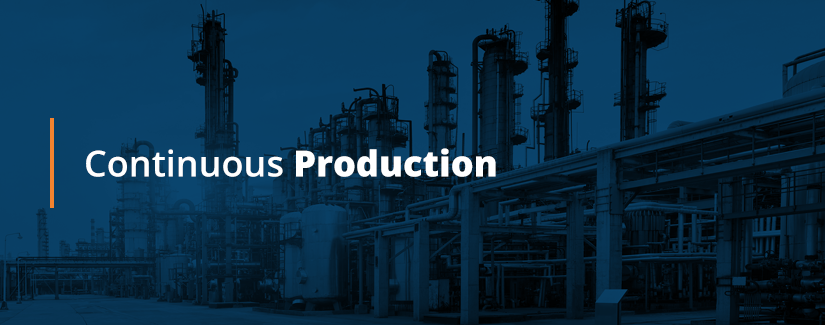
When it comes to choosing a production method, manufacturers have several options. They might choose continuous production, batch production or job production, for example. Continuous production is a method that efficiently produces large quantities in a short amount of time.
It's important manufacturers choose the best production method from the start. Manufacturers must carefully plan and design the production process, and consider the resources and machinery needed to reach company goals. Any mistakes early in operation can set companies back and take substantial capital to fix.
Although continuous production is typically found in large manufacturing settings, any size company in any industry can use the concept of continuous production to boost efficiency and decrease per-unit costs. In this post, we'll look at the benefits and downsides of continuous manufacturing, how it differs from batch production, and types of continuous production systems you can find today.
What Is Continuous Production?
Continuous production is a type of production system in which materials being processed are continuously in motion. Continuous production, like mass production, is a flow production method.
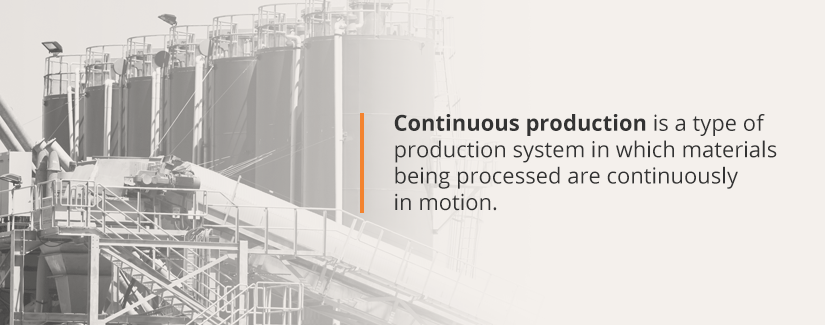
During continuous processing, distinct parts flow from one machine to the next to make a finished product. There are no interruptions between the stages of production. It's a very organized system involving advanced machinery and producing high volumes. In general, continuous production is characterized by:
- Equipment dedicated to specific tasks
- Automated material handling
- Identical products
- Use of specialized machinery and tools
With continuous manufacturing, operations run 24/7. Continuous processing may involve chemicals that cannot be left sitting in pipes or vats. It's important that continuous production manufacturers do not shut down equipment as this may result in a lower quality product. They may shut down machinery after careful weeks of planning when it's time for general maintenance or if they plan to install new equipment. Some light manufacturing companies use semi-continuous processes where it's easy to shut machinery down.
Companies must have high capital to run a continuous production operation. Continuous production requires a large floor space and advanced machinery.
What Are the Advantages of Continuous Production?
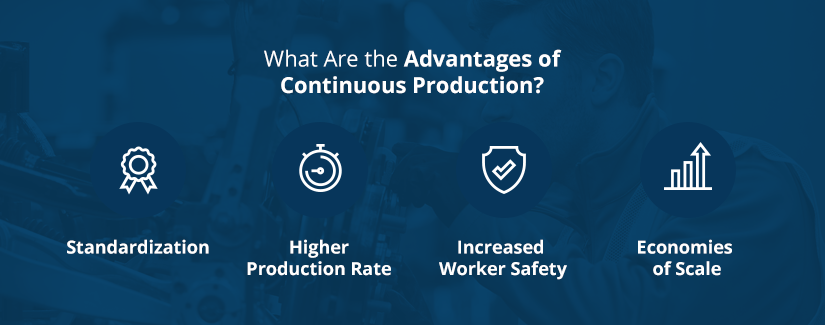
Continuous production has many advantages for large companies with an established customer base. Some of the benefits of continuous manufacturing include:
- Standardization: Continuous production is a carefully monitored, consistent process that uses advanced machinery to produce standardized goods. Manufacturers can expect less risk of human error and products that are identical in quality. This also leads to reduced waste and less downtime.
- Higher production rate: Continuous production never stops running. Without the need to shut down or reset machinery, manufacturers can produce large quantities in less time than a factory that only runs one or two shifts. Continuous production ensures a company can keep up with increasing consumer demand.
- Increased worker safety: With continuous production, materials are handled fully by machinery and flow through a sequence by conveyors or other transfer equipment. It's an automatic process that doesn't put workers in strenuous or dangerous situations.
- Economies of scale: Economies of scale refers to a decrease in overall costs due to increased production. For example, machinery is most efficient when running at one speed. When machinery slows down or stops, it can cause financial loss to a company. A large manufacturer who produces continuously only slows down for certain occasions, such as scheduled maintenance. Otherwise, they can produce 24/7 without the expense of stopping machinery. They can turn raw materials into consumer goods efficiently, and charge consumers affordable prices as a result.
What Are the Disadvantages of Continuous Production?
Continuous manufacturing keeps a company efficient and highly productive. However, it's not the best method of production for every manufacturer. Here are a few reasons why some companies do not run continuously:
- Requires a high investment: Setting up a continuous production plant requires a substantial amount of capital. Automated machinery and robotics are not cheap – nor is the floor space needed to hold such equipment. For this reason, smaller companies typically do not start with a continuous production method.
- Lack of flexibility: Continuous production plants are usually designed to produce a single product. As consumer needs frequently change, this lack of flexibility can be risky. To produce different items, a continuous production manufacturer would have to redesign their whole system.
- Products are the same: Continuous production produces identical items. More consumers want custom or personalized products, but many manufacturers with a continuous processing method are incapable of designing and producing custom items. Although new technology, such as 3-D printers, may help large companies keep up with consumer trends, customization may not be a viable option for all manufacturers.
- Requires extremely careful planning and design: Manufacturers must work with engineers and other design specialists to very carefully plan and create a continuous production operation. Any failure in equipment in an assembly line stops the entire manufacturing process.
- May lead to excess inventory: Continuous production creates high volumes. If consumer demand drops, manufacturers may not be able to sell enough of their products. This can lead to an inventory buildup.
What Is the Difference Between Batch and Continuous Production?
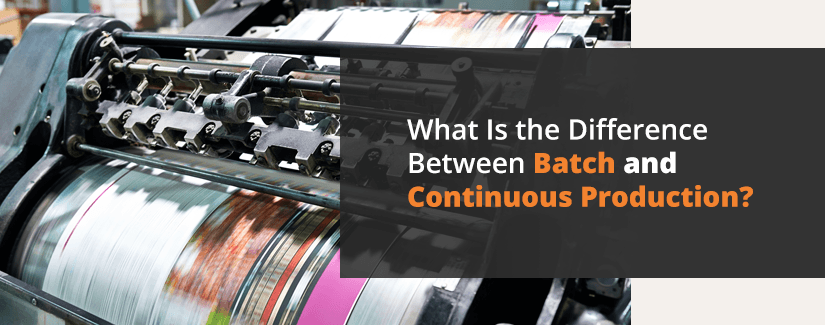
Manufacturers who do not have enough capital to invest in continuous production might opt for batch production instead. Batch production is another main type of production system. It refers to the number of items being produced. With batch production, a company produces items in groups according to an order. For example, a customer might request an order of 700 T-shirts, and another customer might request 300 T-shirts. A clothing manufacturer would then create the first batch of 700 t-shirts. When that batch is finished, they will set up their machines to make the next order of 300 T-shirts.
Unlike continuous production, batch production involves creating products through a series of different workstations. For example, a pharmaceutical company stops production between each step to test for quality assurance. The time between steps can be hours, sometimes weeks. These breaks can put ingredients at risk of degradation and are less cost-effective than if the company kept the operation going continuously. Inefficient batch production costs the pharmaceutical industry billions every year.
Also unlike continuous production, batch production items can be personalized because machines are reconfigured between each batch. For example, if a bakery receives an order for 200 chocolate cakes, and another order for 500 blueberry pies, they will be able to adjust their equipment to fill the orders. Batch production is a flexible manufacturing method, which makes it suitable for producing custom items and seasonal goods.
Other ways batch production is different than continuous production include:
- Machinery must be reset between batches
- Produces smaller quantities
- Uses general purpose equipment
- Workers cannot start a new batch until the first batch is complete
- Common components are made in large quantities and are used to form whole products as needed
- Specifications vary between batches
- Workers must handle materials and possess certain skills
- Customers have to wait longer to get products due to stopping production lines between batch runs
- Requires a lower investment
In general, batch production is best for smaller companies with less capital, or companies that are testing new products. It's a common method used in producing baked goods, pharmaceutical ingredients, sports shoes, clothes, furniture and personalized items. However, if a company has an established name and product, and consumers demand large quantities of the product, it may make more sense to invest in continuous production.
What Are Some Examples of Continuous Production?
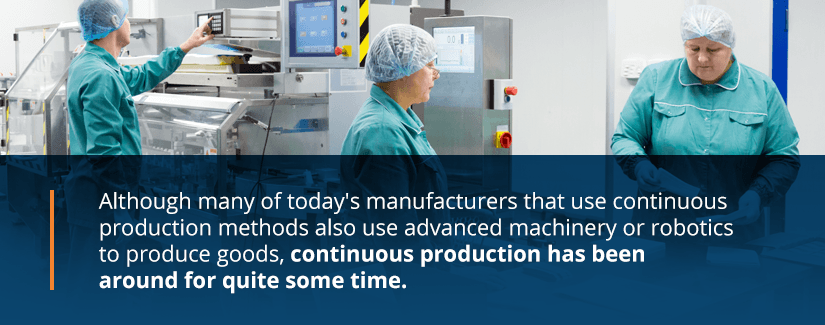
Although many of today's manufacturers that use continuous production methods also use advanced machinery or robotics to produce goods, continuous production has been around for quite some time. For example, the Fourdrinier machine, which Louis Robert invented in 1799 in France, uses a continuous process to manufacture paper. It consists of a moving belt and rollers to press and dry a roll of paper. The machine influenced future continuous production methods.
Another example of early continuous production is Oliver Evans' grain mill. Evans built a grain mill in 1782 and had the idea to connect a water wheel to the milling process, forming a continuous system that would require less physical labor. Evans' system automatically moved grain and flour throughout the mil. Over several years, Evans developed a production line that enabled a single worker to process 300 bushels of grain an hour.
Below are a few modern examples to demonstrate the importance of continuous production, and the role it plays in everyday life.
1. Oil Refineries
An oil refinery converts crude oil into common petroleum products such as gasoline and diesel fuel. A refinery also produces liquids used in chemicals and plastics.
Oil refineries are large, complex facilities that use multiple units to break down crude oil and reconfigure it into new products through various chemical processes. Finished products are stored in large tanks near the refinery before being transported across the country. It's a continuous process that operates 24/7 every day of the year. Considering that Americans consumed 7.28 billion barrels of petroleum products in 2017, or about 20 million barrels a day on average, it makes sense for the oil industry to use continuous production. Without being able to continuously produce such large quantities of petroleum products, it would be impossible to keep up with the demand.
2. Food and Beverage Manufacturers
While small food companies make good use of batch production, large companies, like Hershey and Coca-Cola, need to produce high volumes as efficiently as possible. These companies also have the capital to invest in the most advanced technology to mass produce items.
Consider Hershey. In 2012, Hershey invested $300 million in expanding its plant in Hershey, Pa. The plant contains computers that control the manufacturing process and robotics to handle heavy cases of finished candy. There are more conveyors and machines than human workers in the plant. Those who do work at the plant spend time monitoring computers and production output. This Hershey plant is capable of producing 70 million Hershey's Kisses a day due to continuous production.
Coca-Cola provides another example of continuous flow. One of their facilities in Baton Rouge runs 24 hours a day, five days a week, and manufactures over 4 million servings each day. This Coca-Cola plant is a massive facility equipped with automated machinery to rapidly produce Coke products.
3. Paper Manufacturers
Paper manufacturing is a complex process that involves various machines and processes to turn logs into paper. First, logs are put through machines to remove the bark and then ground into wood chips. Wood chips are then cooked in a special solution inside a large vat called a digester. A digester is designed to handle large volumes and run continuously. As it runs, it efficiently turns wood chips into a pulp. The pulp is then pumped into automated machines and moves through rollers to be pressed and dried.
According to the U.S. Environmental Protection Agency, Americans use about 69 million tons of paper a year. The paper industry, like other industries that use continuous manufacturing, needs to be able to produce large quantities of standardized products.
4. Cement Manufacturers
Cement manufacturing requires a continuous process to ensure the right chemical transformations take place. Cement manufacturing must run 24/7. The usual method of making cement is to crush raw materials such as limestone and clay. These crushed rocks are combined with other materials such as iron ore then ground together, mixed thoroughly and sent into a kiln. Inside the kiln, the materials are heated to approximately 2,700 F. After chemical changes take place, the materials move from the kiln and undergo other automatic processes until the final product is reached. Cement is a critical material used in construction. In 2015, the U.S. consumed 97.1 million metric tons of cement. Continuous production made this possible and continues to do so.
5. Other Examples
Here are a few other examples of industries that may use continuous production methods in their facility:
- Steel
- Chemicals
- Glass
- Electronics
- Automobiles
Reach out to Global Electronic Services
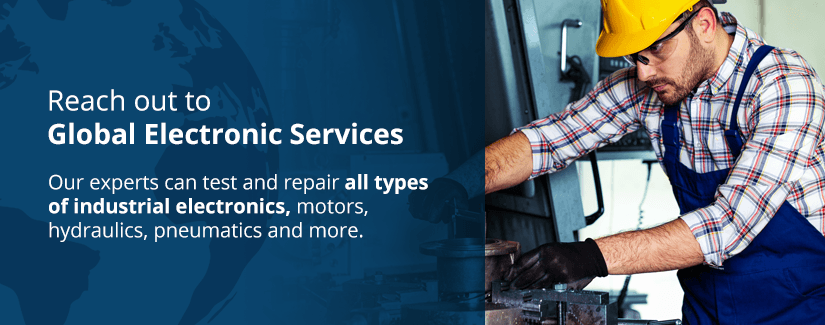
Manufacturers of all sizes can benefit from more efficient machinery and production methods, whether their operations are large or small. If your company needs an industrial repair to get back on track, reach out to us at Global Electronic Services. Our experts can test and repair all types of industrial electronics, motors, hydraulics, pneumatics and more. Keep your operations running smoothly and request a quote today!
Source: https://gesrepair.com/continuous-production/
0 Response to "The Equipment Used in a Continuous Process is"
Post a Comment